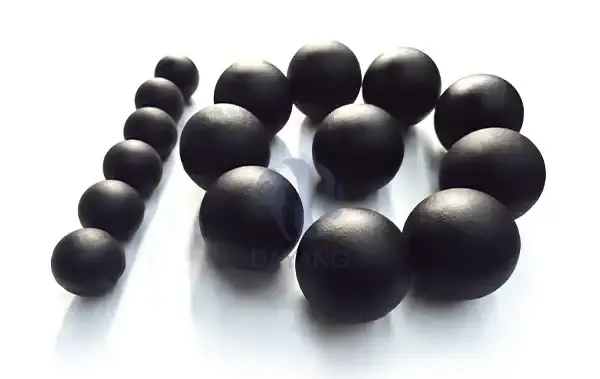Environmental Impacts of Grinding Ball Production
Energy Consumption and Carbon Footprint
The manufacturing process of grinding balls for mining is energy-intensive, especially during the smelting and casting stages. In these stages, high temperatures are necessary to melt and shape raw materials such as steel or cast iron into spherical grinding media. This requires substantial amounts of electricity and fuel, which significantly contribute to the carbon footprint of the mining industry. The energy consumed in this process not only increases operational costs but also raises concerns about the environmental impact, especially in terms of greenhouse gas emissions. To mitigate these concerns, many manufacturers are making significant investments in energy-efficient technologies and cleaner production methods. One such approach is the use of electric arc furnaces powered by renewable energy sources, which helps reduce the reliance on traditional fossil fuels and lower carbon emissions during production. These furnaces offer more control over the heating process, improving energy efficiency. In addition, some manufacturers are implementing advanced heat recovery systems to capture and reuse waste heat generated during production. By recycling this heat, these systems enhance the overall energy efficiency of the process, reducing the amount of energy required to produce grinding balls. These efforts not only help in reducing the environmental impact of manufacturing grinding media but also contribute to the sustainability of the mining industry.
Raw Material Extraction and Resource Depletion
The production of grinding balls requires the extraction of raw materials, primarily iron ore and other alloying elements. This mining activity can lead to habitat disruption, soil erosion, and water pollution if not managed responsibly. Moreover, the extraction of these resources contributes to the depletion of non-renewable mineral deposits. To mitigate these impacts, some manufacturers are exploring the use of recycled materials in grinding ball production. By incorporating scrap metal and other recyclable sources, they can reduce the demand for virgin raw materials and minimize the environmental impact associated with resource extraction. This circular economy approach not only conserves natural resources but also helps reduce the overall carbon footprint of grinding media production.
Environmental Considerations During Mining Operations
Wear and Contamination
During the grinding process, grinding balls for mining undergo gradual wear due to constant impact and abrasion. This wear results in the release of fine metal particles into the ore slurry. If not properly managed, these particles can contaminate water sources and soil, potentially affecting local ecosystems and biodiversity. To address this concern, mining companies are implementing advanced filtration and water treatment systems to remove metal particulates from process water before discharge. Additionally, the development of more wear-resistant grinding media has helped reduce the rate of contamination. High-chrome grinding balls, for instance, offer superior hardness and durability, resulting in less wear and fewer contaminants released into the environment.
Energy Efficiency in Grinding Processes
The efficiency of grinding operations has a direct impact on energy consumption and, consequently, the environmental footprint of mining activities. Inefficient grinding can lead to excessive power usage, increased greenhouse gas emissions, and higher operational costs. To improve energy efficiency, mining companies are adopting optimized grinding ball compositions and sizes tailored to specific ore types. This customization allows for more effective grinding, reducing the time and energy required to achieve desired particle sizes. Furthermore, advanced process control systems and predictive maintenance techniques are being employed to ensure optimal grinding performance, minimizing energy waste and maximizing productivity.
Strategies for Minimizing Environmental Impact
Sustainable Manufacturing Practices
Manufacturers of grinding balls for mining are increasingly adopting sustainable practices to reduce their environmental impact. This includes implementing ISO 14001 environmental management systems, which provide a framework for continual improvement in environmental performance. Some companies are also pursuing certifications such as the Responsible Steel Standard, which addresses sustainability across the entire steel supply chain. Another key strategy is the development of eco-friendly coating technologies for grinding media. These coatings can enhance the durability and performance of grinding balls while reducing the release of harmful substances into the environment. Some manufacturers are exploring biodegradable coatings that offer protection during use but break down naturally over time, minimizing long-term environmental impact.
Recycling and Proper Disposal
The lifecycle management of grinding balls is crucial for minimizing their environmental impact. At the end of their useful life, grinding media can be recycled to recover valuable materials and reduce waste. Many mining companies have implemented recycling programs to collect and process spent grinding balls, reintroducing the reclaimed materials into the manufacturing process. For grinding balls that cannot be recycled, proper disposal methods are essential to prevent environmental contamination. This may involve treating the spent media to neutralize any potentially harmful substances before disposal in authorized landfills. Some innovative companies are exploring ways to repurpose spent grinding balls, such as using them as aggregate in concrete production or as ballast in civil engineering projects, further extending their useful life and reducing waste.
In conclusion, while grinding balls for mining do have environmental impacts, the industry is making significant strides in minimizing these effects. Through sustainable manufacturing practices, efficient use in mining operations, and responsible end-of-life management, the environmental footprint of grinding media can be substantially reduced. As technology advances and sustainability becomes increasingly prioritized, we can expect further improvements in the eco-friendliness of grinding balls and their application in the mining sector. For more information about high-quality, environmentally responsible grinding balls for mining and other industrial applications, please contact us at sales@da-yang.com and sunny@da-yang.com. Our team of experts is ready to help you optimize your grinding processes while minimizing environmental impact.









